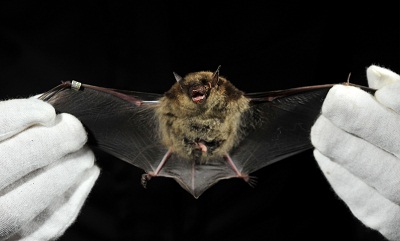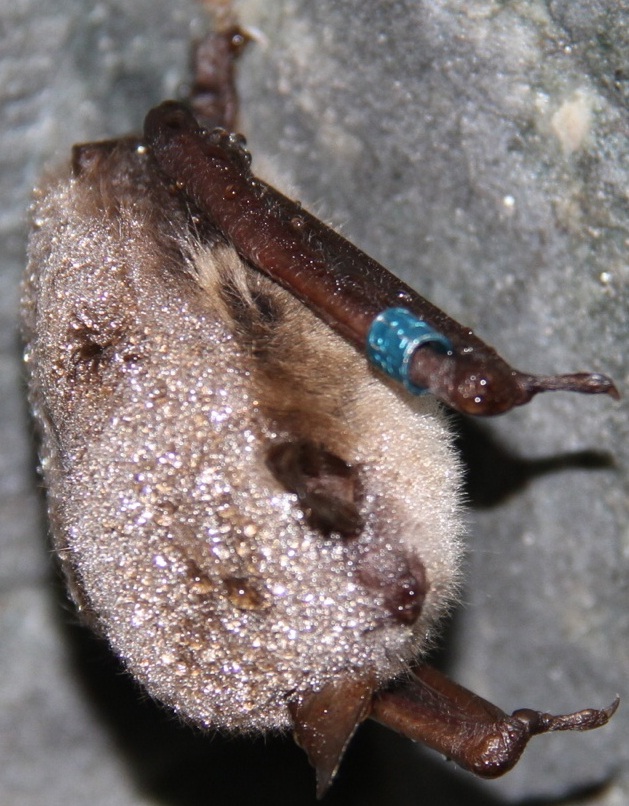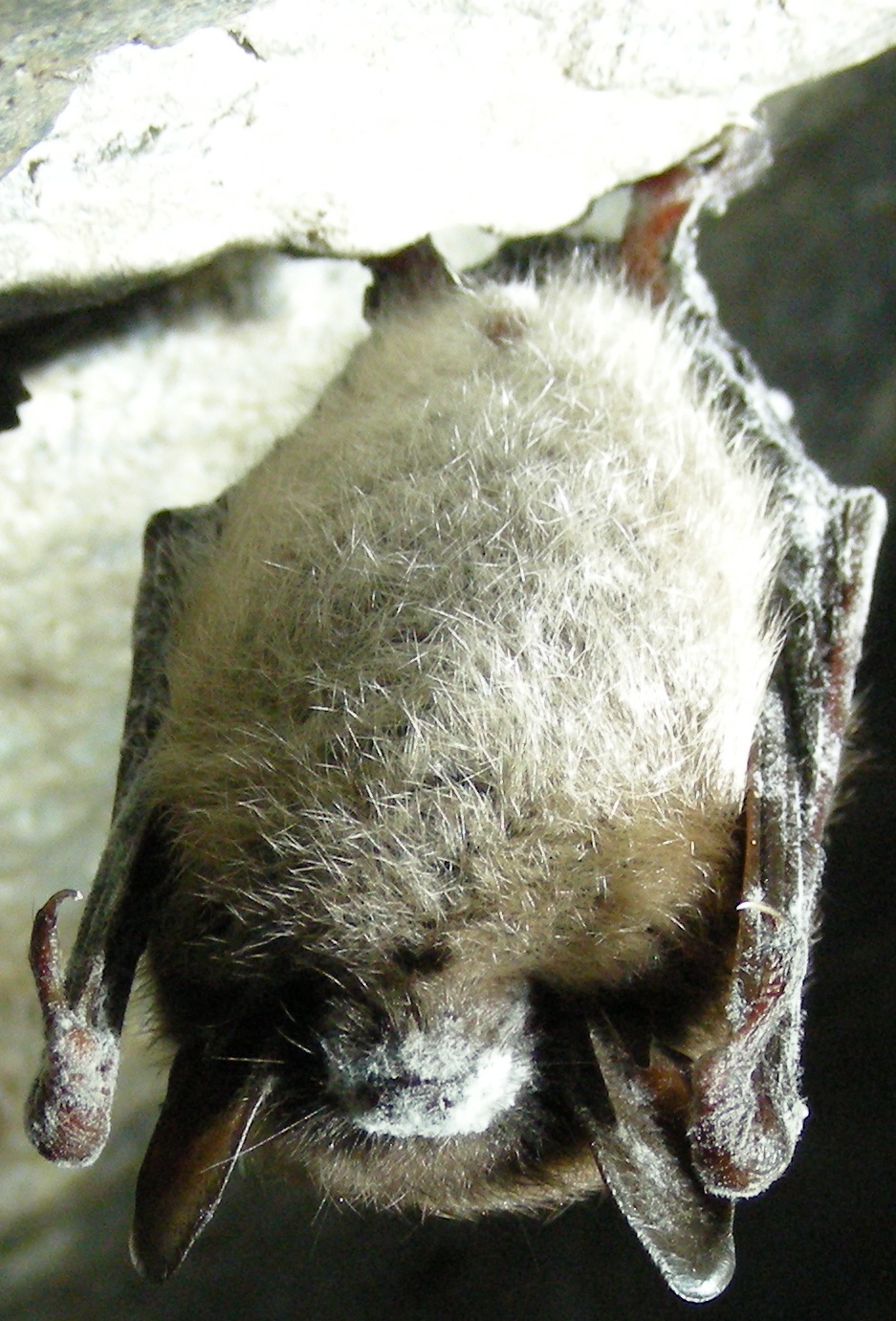Fact Sheet FS1207
Bats are some of the most misunderstood creatures on Earth. While many ancient cultures perceived bats as purveyors of good health and fortune, the majority of popular myths associate bats with death, disease, ghosts, and graveyards. Contrary to these misconceptions, bats are extremely intelligent, adaptive animals that provide many important benefits to humankind. Many people regard bats as pests because some inhabit manmade structures and in some cases pose a rabies risk. However, bats are nonaggressive animals that very rarely interact negatively with humans. Understanding the behavior and habitat requirements of bats can help to minimize conflicts between these valuable species and humans.
Bat Biology and Behavior

Figure 1. Anatomy of a bat, depicting the hand and forearm structure. The wing membrane spreads between the forearms and fingers, and the tail membrane stretches between the legs and tail. (Photo credit: Matt Rainey)
Bats are mammals in the order Chiroptera, which is Latin for "hand-wing." There are over 1,240 species of bats worldwide, making up almost a quarter of all the mammals on Earth. Bats are divided into 2 main subgroups, the fruit or nectar-feeders and the carnivores. Nectar-feeding bats are generally larger than the carnivores and are found primarily in the tropics and subtropics, where food can be acquired year-round. Carnivorous bats feed on both insects and small vertebrates, including rodents, birds, fish, and amphibians. The majority of bats (70%), including those in New Jersey, are primarily insectivorous.
Bats are the only mammals capable of true flight. A bat's wing is anatomically homologous to the human arm, consisting of an upper arm, forearm, wrist, and a hand with four elongated fingers and a clawed thumb, which is used to cling onto any rough surface. Stretching between each finger and the length of the forearm, as well as between the legs and tail, is a double-layered skin membrane, which creates the wing structure (Figure 1).
Bats likely evolved their nocturnal behavior as a way of avoiding predation, and they are presently the only major predator of night-flying insects. Contrary to popular perceptions, bats are not blind. Rather, their eyes are specifically adapted for maneuvering under low-light conditions, helping them to detect prey and avoid obstacles. Many nectar-feeding bats can also see ultraviolet light, helping them to locate flowers during the nighttime hours. In addition to vision, bats rely on other sensory adaptions to navigate and hunt, including their keen hearing, sense of smell, and their use of echolocation. Bats echolocate by emitting several ultrasonic pulses per second into the air that bounce off of surrounding objects and are received by their ears. By comparing the difference in timing and frequencies of returning pulses, a bat can generate an extremely accurate visualization of its surroundings, allowing it to identify other bats and locate tiny, fast-flying insect prey. A bat's flight pattern may seem erratic and haphazard to us, but in fact, each movement the animal makes is calculated and deliberate. The combination of echolocation ability and flight agility allows a bat to detect and avoid an object the thickness of a strand of human hair in complete darkness.
Although bats are associated with living in caves, bats in New Jersey actually occupy a multitude of different habitats throughout the year. During the summer months, many species roost in trees, hanging from high branches and sheltering themselves among the foliage or underneath strips of upturned bark. Other species, such as the little brown bat (Myotis lucifugus), are commonly found in human-made structures, roosting in attics, chimneys, soffits, or within any dark space with a large enough access point. Depending on the species, bats forage in both open areas and woodlands, but they concentrate their activity in places with high insect abundance. Bats are commonly seen feeding near bodies of water, under street lamps, and along woodland edges.

Figure 2. Little brown bat (Myotis lucifugus) in deep torpor while hibernating in an abandoned iron mine in New Jersey. (Photo credit: Eden Buenaventura)
Winter is a difficult time for bats in temperate regions because insect food resources have essentially disappeared. To survive, some bat species will migrate to warmer areas, while others hibernate in caves or mines, called hibernacula. Others, such as the eastern red bat (Lasiurus borealis), will nestle under loose tree bark or within the leaf litter of the forest floor. Hibernation is an extended period during which animals undergo torpor, a physiological state of reduced metabolism. Heart rate and body temperature are decreased dramatically to conserve energy, and the fat stores accumulated prior to hibernation are burned very slowly. The majority of resident bats in New Jersey hibernate in caves or mines (Figure 2). Hibernacula temperatures in New Jersey generally range between 4-13ºC (39-55ºF). Bats begin returning to their hibernaculum in mid- to late summer (July-September), using it as a daily roost for several weeks and leaving at night to feed. Mating occurs at this time, with females storing the sperm and delaying fertilization until they emerge from hibernation the following spring. True hibernation usually begins in mid- to late October in New Jersey and continues through early April, when temperatures rise and insects become more abundant.
Upon emerging from hibernation, bats travel to their summer roosting locations. Females roost together in groups, termed "maternity colonies," where they give birth and care for newborn pups. In most species, females will raise just 1 pup per year, but some species may have up to four. Newborn pups are blind and naked, relying on their mother's milk for nourishment and body heat from their colony mates for warmth. In 4-5 weeks, the pups are almost fully grown and can begin to leave the roost and feed on their own.
Bats of New Jersey
New Jersey supports 6 year-round resident bat species. The 2 species with which humans come into contact most frequently are big brown bats (Eptesicus fuscus) and little brown bats (Myotis lucifugus). Unfortunately, little brown bat populations are declining precipitously due to a disease known as White Nose Syndrome (see Threats and Conservation). Both species prefer to roost in manmade structures during the summer, and big brown bats often hibernate in buildings as well. The eastern small-footed bat (M. leibii) also roosts in buildings during summer, but as a species of special concern in the U.S., it is not observed as frequently as big and little brown bats. The tri-colored bat (Perimyotis subflavus), northern long-eared bat (M. septentrionalis), and federally endangered Indiana bat (M. sodalis) prefer to roost in trees during the summer months, taking shelter beneath peeling bark or in the cavities of dead or dying trees. All New Jersey's resident species hibernate in caves or mines, while some may overwinter in manmade structures.
There are also 3 part-time resident bats in New Jersey, including the hoary bat (Lasiurus cinereus), eastern red bat (L. borealis), and the silver-haired bat (Lasionycterus noctivagans). These species prefer to roost within the foliage of trees or in bark crevices and are rarely seen in manmade structures. These 3 species are generally migratory, travelling south for the winter following similar routes as migratory birds. Hoary bats travel to subtropical and tropical regions, while silver-haired and eastern red bats are short-distance migrants that go through a hibernation cycle each year.
Beneficial Services Provided by Bats
Bats consume high volumes of insects each night and are the only major predators of nocturnal insects. Depending on the species, bats help remove a significant number of agricultural crop pests, reducing the need for chemical pest control. An average-sized colony of 1 million Brazilian free-tailed bats (Tadarida brasiliensis) in Texas can eat 8.4 metric tons of insects per night and have been shown to feed on corn earworm moths and beet armyworm moths, both major corn pests. A colony of 150 big brown bats in Indiana was estimated to devour over 1 million insect pests annually. The hoary bat's diet in Indiana was documented to consist of 43.8% green stink bug, a major pest of tomatoes, peas, soybeans, and corn. These insect pest control services are valued at an estimated average of $22.9 billion annually in the U.S.
In tropical and subtropical regions, bats that feed on pollen, nectar, and fruit play important roles in seed dispersal and pollination of many plant species. These 2 services are critical in the reproductive cycles of plants, which lack the mobility needed to transfer pollen from flower to flower or to establish seeds away from the mother plant. Bats disperse the seeds of both agriculturally important crops, such as cashews, mangos, and papaya, as well as many locally important edible fruits. They are also the primary pollinators of several cactus species, including the blue agave (Agave tequilana), which is used in the production of tequila. Because bats visit many non-commercially valuable species as well, spreading seeds and pollinating flowers, this group of animals is critical in the maintenance of healthy ecosystems.
Bats provide many additional benefits to humans. For example, bat feces (guano) contain high concentrations of nitrogen and phosphorus and historically have been harvested for fertilizer. Bats are commonly used as symbols for movies (Batman), holidays (Halloween), and commercial products (Bacardi rum), helping to generate revenue. Current research is exploring the potential of an anticoagulant compound found in vampire bat saliva to treat stroke victims. Finally, ongoing research of bat echolocation and locomotion is advancing military technology and medical systems.
Negative Bat-Human Interactions
Bats in Homes
Despite their many benefits, bats also have the potential to become nuisance animals through direct interaction with humans. Because many bat species prefer to roost in warm, dark spaces, attics and other man-made structures offer the perfect habitat. When a large number of bats establish a colony inside a structure, significant amounts of guano can build up, potentially creating a health hazard. Histoplasmosis is a respiratory infection caused by inhaling the spores of the Histoplasma fungus, which is found in soil and then enriched by bird or bat droppings. The infection may be asymptomatic or cause flu-like symptoms, but it rarely requires treatment. The majority of those infected heal on their own. While Histoplasma fungus occurs predominantly in soils, its presence has been documented in bat droppings alone. However, histoplasmosis is only a threat where high volumes of guano have collected over several years, and then only when the guano is disturbed and spores are released into the air. These conditions are usually only found in caves or abandoned buildings. Bats roosting inside a home typically do not occur in numbers great enough to produce such quantities of guano. Scattered or small piles of droppings pose no harm and can be swept up with no risk to human health, other than being malodorous, possibly seeping through and staining ceilings and walls. If a bat colony becomes intolerable, there are several strategies to exclude them. See wildlife.rutgers.edu for further details.
Bats are non-aggressive animals; however, a bat that unintentionally enters one's living space can be a frightening experience. The bat is likely confused and is frantically attempting to escape, flying swiftly throughout the house. As there is no food or water in the house, the bat will die if it cannot exit the house within a couple days. To assist the bat in exiting the house unharmed, remain calm, isolate the bat in a single room, and open all the windows (remove the screens). Dim the lights in the room, and, if possible, stand quietly in the corner of the room until you see the bat exit the window. In many cases, the bat may tire and retreat behind a sofa or dresser. Therefore, staying in the room will ensure that the bat has left the house.
Bats and Rabies
Rabies is a fatal viral infection that is spread by the saliva of infected animals, generally through a bite. Although bats are one of the many vectors of the rabies virus, the majority of the estimated 55,000 rabies deaths each year are caused by dog bites. In developed countries, where the majority of domestic pets are vaccinated, rabies is extremely rare but is usually caused by contact with infected wild animals. From 1995-2009, an average of 2 people per year in the U.S. died from contact with rabid bats.
A potential rabies exposure from a bat can only occur through a bite. A bat that is lying on the ground is much more likely to be infected and may bite if handled. According to the Center for Disease Control and the NJ Department of Health, a bat that is found in a house where people are sleeping should be caught and tested for rabies. However, it is highly unlikely that a person could unknowingly be bitten by a bat. Exceptions include young children, the mentally impaired, or those under the influence of alcohol. Therefore, under most circumstances, steps should be taken to allow the bat to freely exit the house (see above).

Figure 3. Characteristic powdery white fungus on the muzzle, ears, and wings of a little brown bat (Myotis lucifugus). (Photo credit: United States Fish and Wildlife Service National Digital Library)
Threats to Bats
The greatest threat to cave-roosting bats is White Nose Syndrome (WNS), a disease caused by the fungus, Geomyces destructans. Since 2006, WNS has killed approximately 5.7 million bats across the eastern United States. Originating in a cave near Albany, NY, WNS has spread to 21 states and 4 Canadian provinces as of 2012, affecting or potentially affecting 11 species. Geomyces destructans is a cold-loving fungus that thrives in temperatures below 20ºC (68ºF). Infection and mortality occur during hibernation, when the bats' immune systems are suppressed. White Nose Syndrome often manifests as a powdery, white substance on the muzzle, ears, and wings of infected bats (Figure 3). Severe infection of the wing membranes often results in tears and holes, hindering flight. In addition, the wings serve vital physiological roles, such as exchange of carbon dioxide, regulation of blood pressure, and thermoregulation; with these functions impaired, the bat experiences diminished immunity. Bats with WNS have also been shown to awaken more frequently from torpor during hibernation and very often starve to death when they are unable to find food during the winter season. Further information, including an updated map of the spread of WNS, can be found at whitenosesyndrome.org.
Human Impacts
One of the major threats to the survival of bats is human disturbance. Caves and mines, critical habitat for many species, are often used for recreational activities. When caves are accessed during winter, disturbance can cause bats to wake from hibernation too frequently, exhausting the body fat reserves they need to survive the winter. In southern regions, where caves are accessed during the spring and summer, newborn pups may be injured or killed inadvertently. In some extreme cases, bats roosting in caves are deliberately persecuted or vandalized.
A relatively new threat to bats is the construction of wind turbines for alternative energy. Along the east coast of the U.S., wind turbines are responsible for the death of 46 bats per turbine per year, on average. By 2020, it is estimated that wind turbines in the Mid-Atlantic region will kill up to 111,000 bats. While the risk of colliding with turbines or being struck by rotating blades exists, most bats die from internal hemorrhaging caused by the sudden drop in air pressure near the moving propellers. Conservationists are currently exploring strategies to minimize turbine-associated mortality, including ceasing turbine operations during periods of high bat activity.
Other threats include pesticide and herbicide use, which reduces the amount of prey available to foraging bats. Some of these chemicals can also poison individuals. Water pollution also decreases insect abundance, which can have significant impacts on many bat species. Both large-scale deforestation, as well as the removal of dead or dying trees, eliminates suitable roosting sites for bats. Finally, the eviction of bats from man-made structures also displaces bats and contributes to habitat loss.
Bat Conservation
Several nonprofit groups are dedicated to bat conservation, engaging in public education initiatives and protective measures for vulnerable species. Research to address WNS is ongoing, with several major universities and state and federal agencies leading the charge. On a local scale, conservationists promote the installation of bat houses as a means of increasing suitable bat habitat. Bat houses are artificial roosting structures that provide bats with an alternate site to establish a colony. Bat houses can be mounted on poles or on the sides of man-made structures and have been shown to be effective in attracting bats. Mounting a bat box prior to properly evicting a bat colony will provide a new roost for the evicted colony. For more information on the proper construction and placement of a bat house, see wildlife.rutgers.edu.
References
Baerwald, E.F., G.H. D'Amours, B.J. Klug, and R.M.R. Barclay. 2008. Barotrauma is a significant cause of bat fatalities at wind turbines. Current Biology 18:R695-R696.
Blehert, D.S. 2012. Fungal disease and the developing story of bat white-nose syndrome. PLoS Pathogens 8(7):e1002779. doi:10.1371/journal.ppat.1002779
Boyles, J.G., P.M. Cryan, G.F. McCracken, and T.H. Kunz. 2011. Economic importance of bats in agriculture. Science 332:41-42.
Harvey, M.J., J.S. Altenbach, and T.L. Best. 2011. Bats of the United States and Canada. Baltimore, MD: Johns Hopkins University Press.
Kunz, T.H., E.B. De Torrez, D. Bauer, T. Lobova, and T.H. Fleming. 2011. Ecosystem services provided by bats. Annals of the New York Academy of Sciences 1223:1-38.
Webb, P.I., J.R. Speakman, and P.A. Racey. 1996. How hot is a hibernaculum? A review of the temperatures at which bats hibernate. Canadian Journal of Zoology 74:761-765.
April 2013
Copyright © 2024 Rutgers, The State University of New Jersey. All rights reserved.
For more information: njaes.rutgers.edu.
Cooperating Agencies: Rutgers, The State University of New Jersey, U.S. Department of Agriculture, and Boards of County Commissioners. Rutgers Cooperative Extension, a unit of the Rutgers New Jersey Agricultural Experiment Station, is an equal opportunity program provider and employer.

